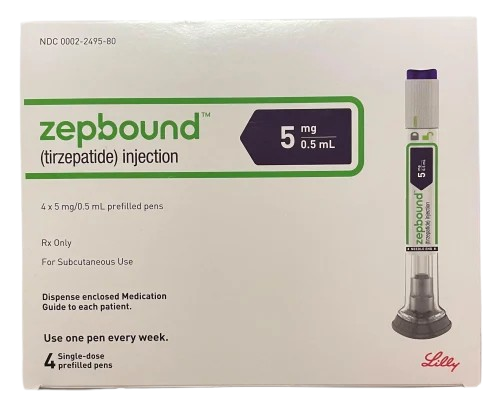If you’re using Ozempic and have heard about the potent weight loss results of Zepbound, you’re likely asking a compelling question “Can you switch from Ozempic to Zepbound?”
The answer is yes, transitioning from Ozempic (semaglutide) to Zepbound (tirzepatide) is a common and medically valid strategy. However, this switch involves more than just changing pens; it’s a shift to a different medication with a dual mechanism, and it requires careful planning with your doctor, especially if your primary goal is managing type 2 diabetes.
This guide will cut through the confusion, providing a clear, safety-first roadmap for this transition, including a detailed dosing schedule and critical advice on navigating the prescription process.
Ozempic vs. Zepbound: It’s More Than Just Weight Loss
Understanding the fundamental difference between these two medications is the first step.
- Ozempic (Semaglutide): A GLP-1 receptor agonist approved for type 2 diabetes. Its primary function is to improve blood sugar control, with weight loss being a beneficial side effect.
- Zepbound (Tirzepatide): A dual GIP and GLP-1 receptor agonist approved for chronic weight management. It is explicitly prescribed for weight loss and can also significantly improve blood sugar levels.
The Critical Takeaway: While both are effective for glucose control, Zepbound is specifically engineered and approved for maximum weight loss efficacy. This is the core reason for making the switch.
Why Make the Switch? Common Reasons to Discuss with Your Doctor
Patients and their providers consider this switch for several key reasons:
- Prioritizing Weight Loss: You have achieved good glycemic control on Ozempic, but you need a more powerful tool to address significant excess weight or obesity.
- Hitting a Plateau: Your weight loss has stalled on the highest tolerated dose of Ozempic, and you are seeking greater efficacy.
- Dual Benefits: You want the potent weight loss of Zepbound while maintaining the blood sugar benefits you experienced with Ozempic (which Zepbound also provides, as its sibling Mounjaro is approved for diabetes).

The Medically-Supervised Transition Plan: A Dosage Guide
This is the most critical safety information. Your body has no tolerance for tirzepatide. Therefore, you must start Zepbound at the 2.5 mg or 5.0 mg dose, regardless of your current Ozempic dose.
The following is a prudent, medically-informed framework for your discussion with your doctor.
| Current Ozempic Dose | Recommended Starting Zepbound Dose | Clinical Rationale |
|---|---|---|
| Ozempic 0.25 mg or 0.5 mg | Zepbound 2.5 mg | You are on a low, introductory dose. Starting at the lowest Zepbound dose is the safest approach. |
| Ozempic 1.0 mg | Zepbound 2.5 mg or 5.0 mg | Your doctor may opt for the 2.5 mg dose for maximum tolerability or the 5.0 mg dose as a step-up from your current GLP-1 exposure. |
| Ozempic 2.0 mg (Max Dose) | Zepbound 5.0 mg | While you are on the highest Ozempic dose, you have no tolerance for tirzepatide. Starting at 5.0 mg acknowledges your GLP-1 experience while prioritizing safety. |
Timing Your First Dose:
The standard protocol is to administer your first Zepbound injection exactly one week after your last scheduled dose of Ozempic. This prevents the effects of the two medications from overlapping, reducing the risk of compounded side effects.
Navigating the Practical Hurdles: Prescription and Insurance
This is a crucial differentiator from the Wegovy switch. Ozempic is a diabetes drug; Zepbound is a weight loss drug.
- The Diagnosis Code is Key: Your insurance company covers Ozempic based on a diagnosis of type 2 diabetes. To cover Zepbound, they require a diagnosis of obesity or being overweight with a weight-related comorbidity.
- A New Prior Authorization (PA): You will need a brand new PA for Zepbound. Your doctor must submit clinical notes that justify the medical necessity for weight management, which may include your BMI and related health conditions.
- The Savings Card: If you are commercially insured and Zepbound is covered, you should use the manufacturer’s savings card to reduce your copay.
Pro Tip: Discuss the diagnosis and insurance strategy with your doctor before they send the Zepbound prescription to the pharmacy to avoid denials and confusion.
What to Expect: Side Effects and Efficacy
- Side Effect “Re-set”: Be prepared to potentially re-experience the initial side effects you had when starting Ozempic (mild nausea, constipation, etc.). Your body is adapting to a new, dual-acting medication. Re-institute your side-effect management strategies from day one.
- Increased Efficacy: Most users report a significant increase in appetite suppression and a reduction in “food noise” after switching, thanks to the dual-hormone action of tirzepatide.
- Glucose Monitoring: If you are switching for weight loss but have a history of diabetes, it remains crucial to continue monitoring your blood sugar as directed by your doctor to ensure Zepbound is providing adequate control.
The Final Word
So, can you switch from Ozempic to Zepbound? Yes, and it can be a highly effective move for both weight loss and glycemic control. The success of this transition hinges on a safe, low-dose start of Zepbound, a clear understanding of the change in treatment goals, and a proactive approach to managing the insurance and prescription process.
This switch represents a strategic step in personalizing your treatment plan to best meet your health objectives.